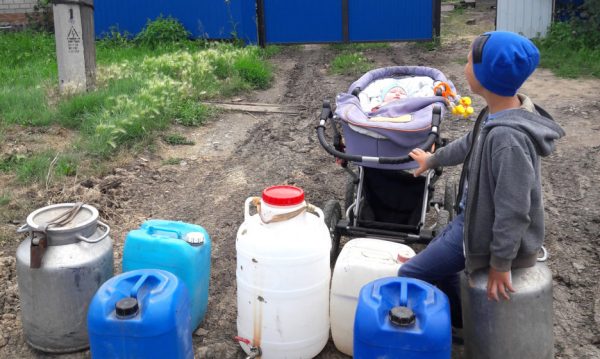 In the Isilkul district of the Omsk region on July 17, an emergency regime was introduced: the drinking water ran out. Almost 40 thousand residents have been living without it for a week. In abnormal heat, people are forced to save drinking water: drink less, wash themselves less often. The water that is brought to them by cars is not enough.
In the Isilkul district of the Omsk region on July 17, an emergency regime was introduced: the drinking water ran out. Almost 40 thousand residents have been living without it for a week. In abnormal heat, people are forced to save drinking water: drink less, wash themselves less often. The water that is brought to them by cars is not enough.
The water in Isilkul disappeared on July 13. First it disappeared from the taps, which at first did not bother anyone: this happened quite often. Isilkul is a steppe city, located 150 kilometers from Omsk, from where there is a water supply. Problems with water began here in the 90s, after the collapse of the Soviet Union.
The Lyubino-Isilkul water pipeline feeding the region with a population of 40 thousand was created back in the USSR. Drinking water, however, is delivered by cars to 20 out of 60 villages. The water towers that the state farms built for their residents have long been destroyed.
They Are Afraid That the Pipes Will Break
“In the central district control room they say that Omskoblvodoprovod gives a small water pressure. The pipes are old, they are afraid that they will break”, the deputy of the Isilkul rural settlement Valentina Brishchenko says. “The pipes are worn out for a long time, and the load is increasing: Isilkul is gradually building up. New consumers are connected to the old water supply system, which is not designed for such volumes.”
She explains that most of the residents brought water to private houses. This also increased the load. Hence the constant interruptions in water supply appear.
“At the end of June, we lived without water for four days”, Valentina continues. “I have 15–20 plastic five-liter containers in which I make supplies under the bathroom. We together with our neighbors have mastered the washing machine long ago. We know where, how much, at what minutes to pour water manually: the pressure is so weak that it does not automatically fill up. At night, the water is turned off: they explain that the reservoirs are small, it is necessary that the required amount accumulates for a day. I live in a three-story building where water often does not rise: people carry buckets from a stand-pipe to the second and third floors.”
But there is no water in the stand-pipes either. However, according to the deputy, they themselves are a continuous headache.
“In my district, a significant part of them does not work”, she says. “People have to cover kilometers, although, according to the instructions, the stand-pipes should be within 100 meters of the house. There are only wells left from many of them, covered from above with some lids. You have to stick your hand in there, get the hose… What kind of hygiene is there, not to mention the fact that it’s easy to fall down there and anyone can spit there, excuse me? My appeals to Omskoblvodoprovod have yielded nothing for five years. “Why should we keep a stand-pipe if there is no running water only in three or five houses in the street?” they reply.
Frightened residents of Isilkul, finding that supplies were running out, swept all the bottles with mineral water off the shelves and began to demand an answer from the authorities.
“Due to the abnormally hot weather, the consumption of drinking water for watering household plots has increased, which in turn leads to a decrease in pressure in the water supply network, and end consumers are left without water. There is also the use of individual pumping stations by residents, which leads to an imbalance in the water supply system. When the resource supplying organization increases the pressure in the network, the main water supply network breaks. At present, to resolve the situation, a schedule for water supply is being coordinated with the district administration”, this explanation was spread in the media by the regional ministry of energy and housing and communal services.
“We saved water, didn’t drink tea”
The regional authorities, together with the service organization CJSC “Omskoblvodoprovod”, organized the supply of water and made a schedule. But it didn’t work well. According to Pavel Trofimov, deputy head of the Isilkul administration, there were not enough cars. There were only four water carriers for 22 thousand residents of Isilkul, and besides, only 200 cubic meters of water remained in the reservoirs. In Isilkul, people stood for hours in courtyards with bottles, basins and buckets under the scorching sun, waiting for a water truck.
“Little by little it got back on track, but at first everything was sad”, Valentina Ivanovna says. “There were a lot of elderly people, children in the queue, everyone needed water. And they still needed to carry it home. Although the quality is so poor that after a couple of hours, mucus accumulates on the sides of the container. But they couldn’t complain: at least some water. There was not enough water for everyone: people from one side of the street filled their bowls, and the other side would not get it. They were indignant, of course. Toilets became a big problem, and, oddly enough, those who had not chase after civilization, leaving street toilets in private houses, were in a better position.”
Most fortunate were those who had never seen civilization. There had been no drinking water in Novorozhdestvenka for 30 years, and its almost week-long absence didn’t become a problem.
“In Soviet times, the state farm built its own tower, however, we did not drink that water for long: it quickly became rotten, because the farms were all around,” old-timer of Novorozhdestvenka, Ivan Kanaev recalls. “Since then they have been bringing us water on Mondays, Wednesdays and Fridays: it costs 25 rubles for a flask, two flasks are enough for a week for me and my wife. Now they had not brought it for a week: they said there was nowhere to collect it, the tanks were empty. But you can wash yourself and water plants with the bad water. Of course, we saved drinking water, didn’t drink tea very often.”
Even the wells preserved in some private estates, dried up from the abnormal heat: it was more than 30 degrees for two weeks.
“Well, it happens, sometimes it is not enough, but the rain passes, and it fills up again, but here there was nothing but our own supply”, the retired teacher Nina Klypa laments. “A 13-year-old grandson from the city came to me to recover. And what kind of recovery can be if you can’t really wash?
We wash the dishes in a basin, rinse them out of a bottle, in which we made holes to save water, I laugh that we still have civilization: outside the window, people are queuing with flasks.
He laughs, of course…”
Only in the largest farm of the Isilkul district “Solnechny” did they quickly find a way out. Its head came up with the idea of delivering water to the residents of Solntsevka in milk carriers after the milk was delivered to the point of delivery.
Local deputy Tatyana Gracheva, however, laments: “They should have left the wells operating, but they were filled up when the water supply had been installed. We should go back to basics: our parents knew what they were doing.”
On July 17, emergency regime was declared in Isilkul district.
“The Lyubino-Isilkul water pipeline, which is maintained by the “Omskoblvodoprovod” company, cannot provide water supply to the district,” commented Pavel Trofimov. “We wrote a letter to the government of the Omsk region with a request to introduce a water supply schedule, taking into account the limits of other districts at the pipeline. We will not be able to stabilize the situation until we are introduced to the time-based water supply with limits in other districts that are on the transit way.”
On July 21, the Governor of the Omsk Region, Alexander Burkov, together with the representatives of the service organization went to Isilkul.

Governor of the Omsk Region
“For decades, water pipelines were neglected. As a result, we have interruptions in water supply in the districts and justified claims to the authorities. Today I personally supervised the execution of instructions given on failures at the facilities of the Lyubino-Isilkul water pipeline. The reason for the long absence of water was an emergency power outage at the “Piketnoye” pumping station. Hot weather and breaks of pipes built in 1978 added work to resource workers… The problem is systemic. We have outlined a plan for a comprehensive solution,” he said on his Instagram page.
Wait for the rain?
It’s not the first time Isilkul residents are promised to solve the problem. Governor Leonid Polezhaev started it back in 2011, having also drawn up a plan. In 2013, another governor, Viktor Nazarov, reported to the President of Russia that he had fulfilled his order given after the appeal of a resident of Isilkul. “Work has been done to replace worn-out sections of the water supply system, overhaul of the pumping station has been made, which will reduce the accident rate on the main water supply networks”, he said.
In 2019, the Federal Security Agency in the Omsk region opened a criminal case against “unidentified employees of the Isilkulsky district administration” over payment for the reconstruction of water supply networks in the amount of 31.5 million rubles. The employees of the agency “acknowledged a completely inoperative state of the water supply system.”
Leonid Polezhaev, who had been managing the region for 20 years, is now an Honorary Citizen of the Omsk Region. Viktor Nazarov, having worked for 4 years in the region, became a senator from the Omsk Region. The persons involved in the criminal case in the regional administration have not yet been identified. And Isilkul people are still suffering without water. And not only they: the regional centers Moskalenki and Maryanovka are with them on the same branch.
“There are problems every summer: at 12 at night the water is turned off, at 6 in the morning they turn it on. But it runs in such a trickle that you can’t wash in the shower”, Olga Khokhlova, a resident of Moskalenki, where the water disappeared on July 15, says. “Something has rotted there, it breaks constantly, we call Omskoblvodoprovod all the time. But before it was still possible to make a supply, at least to wash yourself. Now the bucket is not filled in three hours even in my private house. In two-story buildings there is no water at all. What has changed since last year? The number of residents in the Moskalensky district hasn’t increased: people are leaving, there are few cattle. Both the Ministry of Emergency Situations and the district administration answer in the same way: “Wait for the rain, the water in the tanks has run out.” Are we drinking rainwater?”
The administration of the Moskalensky district did not announce an emergency situation. Local authorities urgently published a schedule for the supply of water to two-three-story houses. And it immediately became clear what people were drinking.
“The schedule is not being followed,” a young mother, Anna Vedmedenko says. “According to the schedule the car is supposed to come at 12:00, but it is doesn’t come. I call the district unified dispatch office and ask at what time the delivery of water to our street will be? They say we should wait, the car has left Omsk, it will be here in two hours. But when I call at 2 o’clock, and at 4 o’clock, they answer: “The car is standing near the fire station, there are no hoses to pour water.” They bring water at 6 o’clock. People can neither live nor work all day: they are waiting.”
“I can’t lift more than three kilograms, and, moreover, drag to the second floor, but what can I do?” Anna continues.
“A water truck looking like a cesspool has arrived, the driver pulled out the hose, and dirty water with grass poured from there.
Did they get it somewhere in the pit? We are shocked: do they think we are animals? Do they want us to die? It is impossible to drink it, only use in the toilet.
The governor ordered to completely restore the water supply of Isilkulsky, Moskalensky and Maryanovsky districts, located on the same branch of the water supply system, by 23 July. It is difficult to say how long the water will flow.
The Isilkul district is included in the plan of the “Pure Water” national project: 64 million rubles should be allocated from the federal and regional budgets for the modernization and creation of an additional reservoir in 2020-2021. But it isn’t related to the Moskalensky and Maryanovsky districts. There are no programs for them, although all the three districts have one common water supply system.
“Until now, residents of the Omsk region paid 88.83 rubles per cubic meter of water”, Valentina Brischenko explains. “Since July 1, the price jumped to 91.14 rubles. Why? I have a water meter installed: I consume one and a half to two cubic meters a month. But according to the Omskoblvodoprovod standard, it turns out that everyone uses 10 cubic meters per month. So, those who are not able to install a meter overpay five times. It turns out that the repair is considered in advance, so where is it?”
Translated by Alyona Malafeeva















